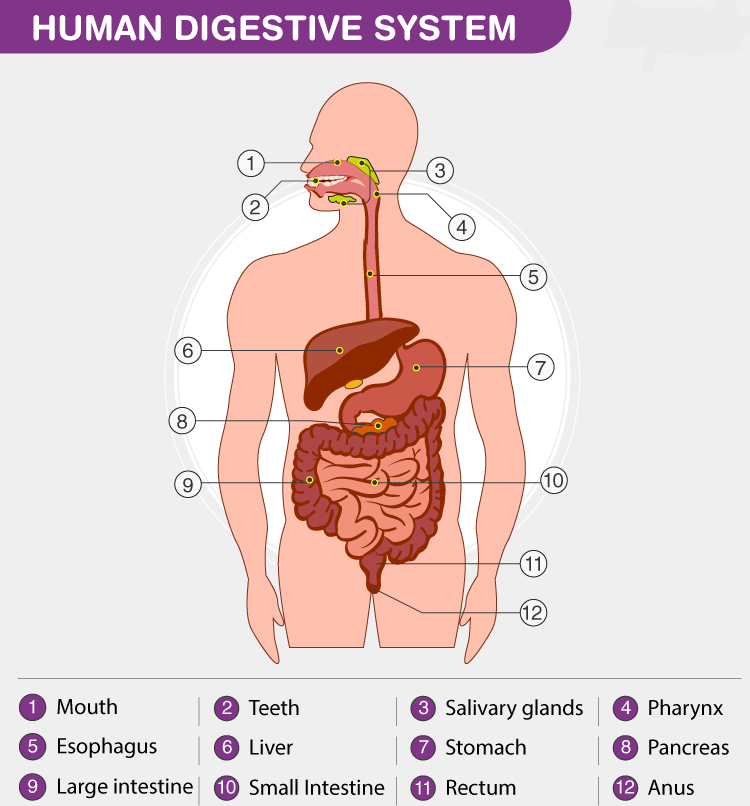Table of Contents
The Human Digestive System
The digestive system of the human body comprises a group of organs working together to convert food into energy for the body. Anatomically, the digestive system is made up of the gastrointestinal tract, along with accessory organs such as the liver, pancreas and gallbladder. The hollow organs that make up the gastrointestinal tract (GI tract) include the mouth, stomach, esophagus, small intestine and large intestine that contains the rectum and anus.
Human Digestive System and Nutrition involve the intake of food by an organism and its utilization for energy. This is a vital process which helps living beings to obtain their energy from various sources. The food which we eat undergoes much processing before the nutrients present in them are utilized to generate energy. This processing is known as digestion. Humans and other animals have specialized organs and systems for this process.
The digestion process involves the alimentary canal along with various accessory organs and organ systems. In humans, the process is quite simple due to our monogastric nature. This means that we have a one-chambered stomach, unlike other animals such as cows, which have four chambers.
Some parts of nervous and circulatory systems also play a significant role in the digestion process. A combination of nerves, bacteria, hormones, blood and other organs of the digestive system completes the task of digestion.
Let us have a detailed look at the human digestive system, its parts and functions.
gastrointestinal: relating to the stomach and the intestines
esophagus: olloquially known also as the food pipe, food tube, or gullet, is an organ in vertebrates through which food passes
Diagram Of The Human Digestive System
The diagram given below represents different parts of the human digestive system that convert food into essential nutrients absorbed by the body.

Parts of the Human Digestive System
The digestive system of the human body comprises a group of organs that work together in converting food into energy and other basic nutrients to power the body. The food we take in is digested and utilized by our body, and the unused parts of the food are defecated.
The digestive system of the human body is the sum of the gastrointestinal tract (GIT; also called alimentary canal) and accessory organs (tongue, liver, pancreas, etc.). These two parts together help in the digestion process.
The alimentary canal is the long tube through which the food that we eat is passed. It begins at the mouth (buccal or oral cavity), passes through the pharynx, oesophagus or food pipe, stomach, small intestines, large intestines, rectum and finally ends at the anus. The food particles gradually get digested as they travel through various compartments of the alimentary canal.
Accessory organs are organs which participate in the digestion process but are not actually a part of GIT. They stimulate the digestion by releasing certain enzymes that help in breaking down the food.
Let us have a detailed look at the digestive system of the human body, along with its parts and functions:
Mouth
Food starts its journey from the mouth or the oral cavity. There are many other organs that contribute to the digestion process, including teeth, salivary glands, and tongue. Teeth are designed for grinding food particles into small pieces and are moistened with saliva before the tongue pushes the food into the pharynx.
Pharynx
A fibromuscular y-shaped tube attached to the terminal end of the mouth. It is mainly involved in the passage of chewed/crushed food from the mouth through the oesophagus. It also has a major part in the respiratory system, as air travels through the pharynx from the nasal cavity on its way to the lungs.
Oesophagus
This is a muscular tube that connects the pharynx, which is a part of an upper section of the gastrointestinal tract. It supplies swallowed food along with its length.
Stomach
It serves as a muscular bag which is situated towards the left side of the abdominal cavity, beneath the diaphragm. This vital organ acts as a storage for the food and provides enough time to digest meals. The stomach also produces digestive enzymes and hydrochloric acid that maintains the process of digestion.
- Mucous: It is an aqueous secretion produced by the mucous membranes. It functions by protecting the stomach lining and gastric pits from the acid, which is produced by the glands to destroy the bacteria that entered along with the food particles.
- Digestive enzymes: They are the group of enzymes which functions by breaking down polymeric macromolecules like biopolymers into their smaller and simpler substances.
- Hydrochloric acid: It is the digestive fluid formed by the stomach during the process of digestion. It functions by destroying harmful microorganisms present in the food particles.
Small Intestine
The small intestine is a thin, long tube of about 10 feet long and a part of the lower gastrointestinal tract. It is present just behind the stomach and acquires a maximum area of the abdominal cavity. The complete small intestine is coiled and the inner surface consists of folds and ridges.
Large Intestine
This is a thick, long tube measuring around 5 feet in length. It is present just beneath the stomach and wraps over the superior and lateral edges of the small intestine. It absorbs water and consists of bacteria (symbiotic) that support the breakdown of wastes to fetch small nutrients.
Rectum
Waste products are passed into the end of the large intestine called the rectum and eliminated out of the body as a solid matter called stool. It is stored in the rectum as semi-solid faeces which later exits from the body through the anal canal through the process of defecation.
Accessory Organs
Pancreas
It is a large gland present just behind the stomach. It is short with its anterior connected to the duodenum and posterior pointing towards the left part of the abdominal cavity. The pancreas releases digestive enzymes to complete the process of chemical digestion.
Liver
The liver is a roughly triangular, reddish-brown accessory organ of the digestive system located to the right of the stomach. It produces bile, which helps in the digestion of fat in the small intestine. The bile is stored and recycled in the gallbladder. It is a small, pear-shaped organ which is located just next to the liver.
Digestion Process
The process of digestion begins from the mouth and ends in the small intestine – the large intestines’ main function is to absorb the remaining water from the undigested food and enable bacterial fermentation of materials that can no longer be digested.
The alimentary canal or the gastrointestinal tract is a series of hollow organs and tubes that begins from the mouth cavity and continues into the pharynx, through the stomach, small intestines, large intestines, and finally ending at the anus. Food particles gradually get digested as they travel through various compartments of the gastrointestinal tract.
The digestion process takes place in the following steps.
Ingestion
The very first step involves mastication (chewing). The salivary glands, along with the tongue, helps to moisten and lubricate food, before being pushed down into the food pipe.
Mixing and Movement
It involves the process of lubricating and manipulating food and pushing it down the food through the food pipe (using peristalsis), and into the stomach.
Secretion
The stomach, small intestine, liver, and pancreas secrete enzymes and acids to aid the process of digestion. It functions by breaking down food particles into simple components and easily absorbable components.
Digestion
The process of converting complex food particles into simpler substances in the presence of enzymes and acids secreted by different digestive organs.
Absorption
This process begins in the small intestine where most of the nutrients and minerals are absorbed. The excess water in the indigestible matter is absorbed by the large intestines.
Excretion
The process of removing indigestible substances and waste by-products from the body through the process of defecation.
In a nutshell, the digestion process consists of the six following steps:
Ingestion ⇒Mixing and Movement ⇒ Secretion ⇒ Digestion ⇒Absorption ⇒Excretion
Functions of the Human Digestive System
Digestion and absorption are the two main functions of the digestive system.
Digestion is necessary for breaking down food particles into nutrients that are used by the body as an energy source, cell repair and growth.
Food and drink need to be converted into smaller molecules of nutrients before it is absorbed by the blood and carried to the cells throughout the body. The body breaks the nutrients present in the drinks and food into carbohydrates, vitamins, fats and proteins.
Human Digestive System Notes
- The human digestive system breaks down food to release energy essential for the body to carry out its activities.
- The process of digestion takes place in 6 major steps.
- The food is ingested by the alimentary canal and is propelled through the body for further processing.
- The autonomous nervous system controls the peristalsis, contraction and relaxation of muscles within the alimentary canal wall.
- The food is passed to the small intestine where it is digested, and the nutrients are absorbed.
- Water, electrolytes and vitamins are absorbed by the large intestine and the waste is defecated.


Its very good article for learning